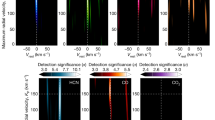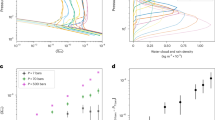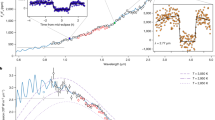Abstract
THE great red spot of Jupiter has puzzled astronomers since its discovery in 1857 (or since 1664 if it is identical with the feature seen by Robert Hooke). It is generally conceded to-day that Jupiter is approximately 80 per cent hydrogen by weight1–3, and the best modern evidence does not conflict with the assumption that hydrogen predominates in the atmosphere of Jupiter to the same extent as in the planet's bulk4. It has proved difficult to conceive of an ‘object’ able to ‘float’ in a surfaceless ocean5 of supercritical hydrogen gas. Therefore the suggestion of Hide6 that the red spot might not be a flotation phenomenon at all but rather a ‘Taylor column’ was an intriguing alternative. Unfortunately, it has not been possible as yet to prove hydrodynamically that a Taylor column can be realized in Jupiter's atmosphere; for one does not know enough about the hydrodynamic conditions of the atmosphere (we shall return to this point later). Moreover, certain observed phenomena appear to indicate that the rather restrictive requirements for the existence of a Taylor column are not met by the red spot. Without here going into these arguments, we merely wish to propose a novel and alternative explanation based on a theoretical prediction of J. D. van der Waals7 which has been verified in some detail by Krichevsky and Ziclis8, Kennedy and Takenouchi9 and others.
This is a preview of subscription content, access via your institution
Access options
Subscribe to this journal
Receive 51 print issues and online access
$199.00 per year
only $3.90 per issue
Buy this article
- Purchase on SpringerLink
- Instant access to full article PDF
Prices may be subject to local taxes which are calculated during checkout
Similar content being viewed by others
References
Ramsey, W. H., and Miles, B., Mon. Not. Roy. Astro. Soc., 112, 234 (1952).
DeMarcus, W. C., Astro. J., 63, 2 (1958).
Peebles, P. J. E., Astrophys. J., 140, 328 (1964).
Owen, T., Astrophys. J., 141, 444 (1965).
DeMarcus, W. C., Mém. Soc. Roy. Sci. Liège, Ser. 4, 18 (1956).
Hide, R., Nature, 190, 895 (1956); Mém. Soc. Roy. Sci. Liège, Ser. 5, 10, 481 (1962).
Onnes, H. Kamerlingh, and Keesom, W. H., Encyklopadie der Mathematischen Wissenschaften, 1, 481 (Teubner, Leipzig, 1921). The original papers of van der Waals are widely scattered. This article has the necessary bibliographical information.
Krichevsky, I. R., and Ziclis, D., Acta Physimchimia U.R.S.S., 18, 264 (1943).
Kennedy, G. C., and Takenouchi, S., Amer. J. Sci., 262, 1055 (1964).
Author information
Authors and Affiliations
Rights and permissions
About this article
Cite this article
DEMARCUS, W., WILDT, R. Jupiter's Great Red Spot. Nature 209, 62 (1966). https://doi.org/10.1038/209062a0
Issue date:
DOI: https://doi.org/10.1038/209062a0



